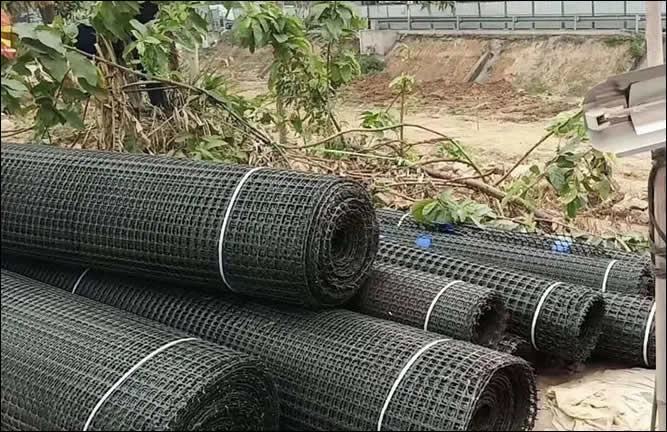Geogrids used in construction to reinforce soils, increase stability, prevent erosion, and enhance load-bearing capacity, in roads, retaining walls, and slope stabilization.

Geogrid is used with gabions for soil retaining and river bank protection gabion wall construction works.
Typical Applications of Geo Grid Products: Geogrids play a crucial role in strengthening foundations and enhancing the overall bearing capacity of infrastructure such as railroads, highways, and aircraft runways. These specialized materials are designed to reinforce the soil, improve stability, and prevent excessive deformation under heavy loads.
Geogrids are commonly used in civil engineering projects where the subgrade soil may be weak or unstable, requiring additional support to ensure long-term durability and safety. Subgrade refers to the natural soil or rock layer upon which the foundation of a road, railway, or runway is built. In many cases, the existing subgrade soil may not possess the necessary strength or stability to support heavy traffic or aircraft loads without undergoing excessive settlement or deformation.
Geogrid has diverse applications in various fields:
Water conservancy projects: Geogrids find extensive uses in projects like embankments, dams, rivers, canals, and reservoirs, in construction and reinforcement.
Highway roadbed construction: Geogrid is utilized in the construction of roadbeds for highways, enhancing their stability and durability.
Building structure reinforcement: Geogrid can be employed in reinforcing the soft foundation of building structures, improving their overall load-bearing capacity.
Airport foundation reinforcement: Geogrid plays a crucial role in enhancing the bearing capacity of airport runways, ensuring safe aircraft take-off and landing operations.
Railroad infrastructure: Geogrid is used in preventing premature settlement and damage to railroad tracks built on soft ground.
Other fields: Geogrid has applications also in waste disposal, power plants, dam projects, coal mines, metallurgy, greening, and containment systems.
How Geogrid Functions in Embankment Soil Retaining Engineering Projects:
1, Geogrids bind soil particles together to reduce deformation and lateral movement of soil particles, while increasing the shear strength of the soil. This improves the stability of the structure and helps protect the underlying soils from excessive erosion and water infiltration.
2, When used in reinforcing embankment slopes, riverbanks, canals, and reservoirs, geogrid meshes are usually placed in layers along the slope of the bank or dam and can be composed of various materials such as steel, polypropylene, glass fiber, or polyester. Depending on the material chosen, geogrids can be designed with various strengths and layouts to meet the required safety factor and structural requirements of the project.
3, Once the geogrid is installed, its grid-mesh structure provides a "lattice" of support for the surrounding soil. This extra support helps to spread out the load applied to the soil, reducing deformation and lateral movement of the soil and providing additional stability for the structure. Geogrids also help to reduce the total amount of fill needed for the construction of an embankment or dam, saving money in materials and labor costs.
4, In addition to providing structural strength and stability, geogrids also help reduce erosion of the underlying soils. The geo-grid structure creates a honeycomb-like pattern in the soil which interlocks the soil particles and prevents them from being washed away during floods or storms. This helps to preserve the underlying soils and reduce the need for expensive maintenance and repair.
Functions of geogrids to improve the foundation and bearing capacity of transportation infrastructure:
Soil Stabilization: One of the primary functions of geogrids is soil stabilization in railway and highway constructions.
Load Distribution: Geogrids act as a reinforcement layer, distributing the applied loads more uniformly across the foundation. By spreading the load over a wider area, geogrids help minimize localized stress concentrations that can lead to soil failure. This load distribution mechanism helps to mitigate the effects of heavy traffic loads or aircraft wheel loads, ensuring that the foundation experiences more even and manageable stress levels.
Tensile Strength Enhancement: When installed within the soil, geogrids resist tensile forces and provide tensile stiffness to the composite soil-geogrid system. This enhancement helps to resist the upward forces induced by the movement of underlying weak soils, minimizing the risk of rutting, surface deformation, or subgrade failure in road projects.
Improving Bearing Capacity: Geogrids enhance the bearing capacity of the subgrade by distributing the loads over a larger area and reducing the contact pressure on the soil. The increased bearing capacity allows the infrastructure to accommodate heavier loads, thus extending the service life of the road, railway, or runway.
Construction over Weak Soils: By reinforcing the subgrade with geogrids, the stability and load-bearing capacity of the foundation can be significantly improved, making it suitable for the construction of transportation infrastructure.
Reducing Subgrade Thickness: By reinforcing the soil, geogrids allow for the use of thinner layers of select fill or granular material, resulting in cost savings and faster construction.
Resistance to Differential Settlement: Differential settlement occurs when different sections of the foundation settle at different rates, leading to uneven surfaces and potential structural damage. Geogrids help mitigate the risk of differential settlement by improving the load-bearing capacity.


